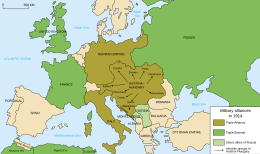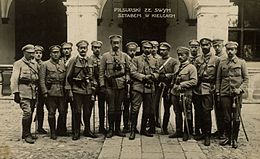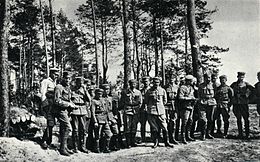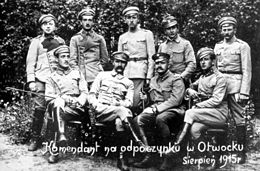Our website is made possible by displaying online advertisements to our visitors.
Please consider supporting us by disabling your ad blocker.
Polish Legions in World War I
| Polish Legions | |
|---|---|
| Legiony Polskie | |
 Europe in 1914, the Triple Alliance in brown Europe in 1914, the Triple Alliance in brown
 Col. Józef Piłsudski with his staff in front of the Governor's Palace in Kielce, 1914 Col. Józef Piłsudski with his staff in front of the Governor's Palace in Kielce, 1914
 Col. Józef Piłsudski and his officers, 1915 Col. Józef Piłsudski and his officers, 1915
 Pilsudski in Otwock, 1915 Pilsudski in Otwock, 1915
 II Brigade of the Polish Legions in Volhynia c. 1915-16 II Brigade of the Polish Legions in Volhynia c. 1915-16 |
The Polish Legions (Polish: Legiony Polskie) was a name of the Polish military force (the first active Polish army in generations)[1] established in August 1914 in Galicia soon after World War I erupted between the opposing alliances of the Triple Entente on one side (comprising the British Empire, the French Republic and the Russian Empire) and the Central Powers on the other side, comprising the German Empire and Austria-Hungary.[2] The Legions became "a founding myth for the creation of modern Poland" in spite of their considerably short existence;[1] they were replaced by the Polish Auxiliary Corps (Polish: Polski Korpus Posiłkowy) formation on 20 September 1916, merged with Polish II Corps in Russia on 19 February 1918 for the Battle of Rarańcza against Austria-Hungary, and disbanded following the military defeat at the Battle of Kaniów in May 1918,[3] against Imperial Germany. General Haller escaped to France to form the Polish army in the West against the anti-Polish German-Bolshevik treaty.[4]
The Legions took part in many battles against the forces of the Imperial Russia, both in Galicia and in the Carpathian Mountains. They suffered heavy casualties outnumbered three to one in the Battle of Łowczówek. They captured Kielce, and in 1915 took part in the offensive on Warsaw. In June 1916 the unit had approximately 25,000 soldiers.[1] Both the number of troops and the composition of units changed rapidly. After the Battle of Kostiuchnówka where 2,000 Polish soldiers died delaying a Russian offensive, Józef Piłsudski demanded that the Central Powers issue a guarantee of independence for Poland and partially succeeded.[5] The Polish Legions became the Polish Auxiliary Corps. After the Act of 5th November of 1916 which pronounced the creation of the puppet Kingdom of Poland of 1916–18, the Polish Legions were transferred under German command. However, most of the members refused to swear allegiance to the German Kaiser and were interned in Beniaminów and Szczypiorno (the Oath crisis). Approximately 3,000 of them were drafted into the Austro-Hungarian army and sent to the Italian Front while approximately 7,500 stayed in the Polish Auxiliary Corps, part of the failed German Polnische Wehrmacht.[citation needed]
- ^ a b c M.B.B. Biskupski (2012). Independence Day: Myth, Symbol, and the Creation of Modern Poland. OUP Oxford. pp. 9–11. ISBN 978-0-19-965881-7.
- ^ Willmott, H.P. (2003). World War I. New York: Dorling Kindersley. p. 15. ISBN 0-7894-9627-5. OCLC 52541937.
- ^ WIEM Encyklopedia (2015), Polski Korpus Posiłkowy at PortalWiedzy.onet.pl (in Polish)
- ^ Spencer Tucker; Laura Matysek Wood; Justin D. Murphy (1996). The European Powers in the First World War: An Encyclopedia. Taylor & Francis. p. 332. ISBN 0-8153-3351-X – via Google Print.
- ^ Urbankowski, Bohdan (1997). Józef Piłsudski: Marzyciel i strateg (Józef Piłsudski: Dreamer and Strategist) (in Polish). Vol. 1–2. Warsaw: Wydawnictwo ALFA. pp. 251–252. ISBN 978-83-7001-914-3.
Previous Page Next Page
Польскія легіёны (1914—1918) BE Polnische Legionen (1914–1918) German Πολωνικές Λεγεώνες στον Α΄ Παγκόσμιο Πόλεμο Greek Polaj Legioj (1914-1918) EO Legiones Polacas (Primera Guerra Mundial) Spanish هنگهای لهستانی در جنگ جهانی اول FA Légions polonaises pendant la Première Guerre mondiale French Legiun Polandia (Perang Dunia I) ID Legione polacca (prima guerra mondiale) Italian Lenkų legionai LT


